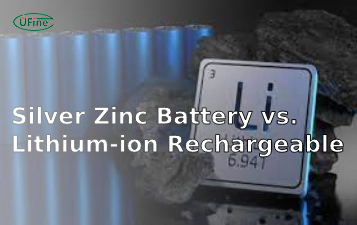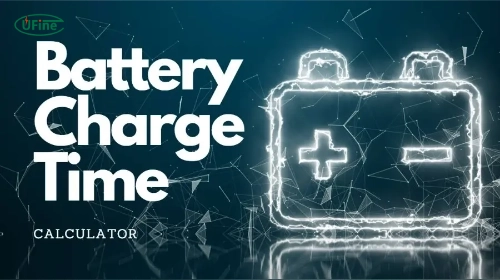
- Find your battery’s capacity in Ah (ampere-hours).
- Determine the safe charge rate (usually 1C for LiPo batteries).
- Multiply capacity (Ah) by C-rate to get charging current (A).
- Divide capacity by charging current to estimate charging time.
- Adjust for charging efficiency (80–90%) for more accurate results.
Example: A 2200mAh LiPo battery at 1C (2.2A) takes about 1 hour, adjusted to 1.1 hours for 90% efficiency.
Whether you’re looking for a LiPo charge rate calculator, a LiPo charging time calculator, or a LiPo battery charge current calculator, the core principle is the same: matching your battery’s specifications with the charger output to ensure safe and efficient charging. This guide and calculator work for LiPo, Li-ion, and LiFePO4 batteries, covering charge rate, current, and total charging time estimation.
Part 1. What is the LiPo charge rate calculator?
The LiPo Battery Charge Rate Calculator is a tool designed to compute the safe charging rate for Lithium Polymer batteries. It considers various battery and charging specifications to provide an optimal charging rate.
Part 2. How to use the LiPo charge rate battery calculator?
When using a lithium battery charge time calculator, accuracy is key. Be sure to input correct specifications such as voltage, capacity, and charge rate.
- 1. Steps to Use the Calculator:
Battery Type Selection: Choose the lithium battery you intend to charge. Standard selections include LiPo (Lithium Polymer), Li-ion (Lithium-ion), and LiFePO4 (Lithium Iron Phosphate), among others. Each type might have different charging characteristics; the calculator accounts for these differences.
- 2. Battery Specifications Input:
Input the specific battery specifications as accurately as possible. This includes the battery’s nominal voltage (V), capacity measured in milliampere-hours (mAh), and, if available, the maximum charge rate recommended by the battery manufacturer.
For instance:
LiPo Battery: Nominal voltage of 3.7V, 2200mAh capacity, maximum charge rate of 2C.
Li-ion Battery: Nominal voltage of 3.6V, 3000mAh capacity, maximum charge rate of 1C.
LiFePO4 Battery: Nominal voltage of 3.3V, 1500mAh capacity, maximum charge rate of 0.5C.
- 3. Charger Specifications Input:
Enter the specifications of the charger you intend to use. This includes the charger’s maximum charge current output (in amperes or milliamperes).
Learn more about how to calculate LiPo charge rate to ensure accurate input values.
For instance:
If using a LiPo battery charger with a maximum charge output of 1.5A, input this value into the calculator.
- 4.Calculation:
Once all required information is entered, the calculator will process the data and compute the recommended charging rate. It will provide the appropriate charge rate for your specific battery, ensuring safe and optimal charging.
- 5. Review and Adjustment:
Check the calculated charge rate against the manufacturer’s recommendations or industry standards for safety. If the estimated rate exceeds the manufacturer’s maximum recommended charge rate, consider adjusting the charger settings to align with the manufacturer’s guidelines.
Learn more about how to calculate LiPo charge rate to ensure accurate input values.
Common Mistakes When Calculating Battery Charge Time
While calculating battery charge time may seem straightforward, there are some common mistakes to avoid:
For safety guidelines, see our LiPo battery safety tips.
- Ignoring Charging Efficiency: Many users overlook that not all energy is effectively transferred, leading to inaccurate charge time estimations.
- Using Incorrect Specifications: Ensure that the input data for the battery and charger matches the manufacturer’s guidelines.
- Overlooking Safety Factors: Always incorporate a safety buffer in the calculation to prevent overcharging.
Tip: Use reliable calculators or tools that improve efficiency and provide safe recommendations.
Part 3. Battery charging time calculator formulas for LiPo, Li-ion, and LiFePO4
Calculating the charging time for a battery involves considering its capacity, charge rate, and specific formulas to estimate the time required for a full charge. The charging time depends on the battery’s capacity and the charging current applied.
Formula 1: Charging Time = Battery Capacity / Charging Current
This basic formula estimates the time needed to charge a battery based on its capacity and the charging current applied.
For example, for a 2000mAh battery charged at 1000mA (1A), the calculation would be 2000mAh / 1000mA = 2 hours.
Formula 2: Charging Time = (Battery Capacity / Charging Efficiency) / Charging Current
This formula considers the charging efficiency, as not all the current supplied during charging goes into the battery due to losses.
For instance, a 3000mAh battery charged at 1A with an 85% charging efficiency would take approximately ((3000mAh / 0.85) / 1000mA) = 3.53 hours.
Formula 3: Charging Time = (Battery Capacity / Charger Output) × 1.5
Often used as a rule of thumb, this formula includes a safety factor (1.5) to prevent overcharging and extend battery longevity.
For a 2500mAh battery charged by a 2A charger, the estimated time would be ((2500mAh / 2000mA) × 1.5) = 1.875 hours.
Pro Tips: You can also verify these results using our LiPo battery charging time calculator.
Examples:
LiPo Battery (2000mAh, 1A Charger):
- a: 2000mAh / 1000mA = 2 hours.
- b: ((2000mAh / 0.85) / 1000mA) = 2.35 hours.
- c: ((2000mAh / 1000mA) × 1.5) = 3 hours.
Li-ion Battery (3000mAh, 2A Charger):
- a: 3000mAh / 2000mA = 1.5 hours.
- b: ((3000mAh / 0.85) / 2000mA) = 1.76 hours.
- c: ((3000mAh / 2000mA) × 1.5) = 2.25 hours.
LiFePO4 Battery (1500mAh, 500mA Charger):
- a: 1500mAh / 500mA = 3 hours.
- b: ((1500mAh / 0.85) / 500mA) = 3.53 hours.
- c: ((1500mAh / 500mA) × 1.5) = 4.5 hours.
By utilizing these formulas and understanding the battery’s capacity, charging current, and efficiency, one can accurately estimate the time required to charge various lithium batteries for safe and efficient charging.
Battery Capacity Unit Conversions:
1.mAh to Ah (Milliampere-Hours to Ampere-Hours):
- Conversion Formula: Battery Capacity (Ah) = Battery Capacity (mAh) / 1000
- For example, a 3000mAh battery is equivalent to 3 Ah (3000mAh / 1000).
2.Coulombs to Ampere-Hours:
- Conversion Formula: Battery Capacity (Ah) = Battery Capacity (Coulombs) / 3600
- For example, 7200 Coulombs equals 2 Ah (7200 / 3600).
3. Watt-Hours to Ampere-Hours (for voltage-dependent batteries):
- Conversion Formula: Battery Capacity (Ah) = Battery Capacity (Wh) / Voltage
- Example: For a 12V battery, 36 Watt-hours equals 3 Ah (36 Wh / 12V).
Battery Charge Rate Unit Conversions:
1. Battery Amps to Milliamps:
- Conversion Formula: Charging Current (mA) = Charging Current (A) * 1000
- Example: 2A charging current equals 2000mA (2 * 1000).
2. Battery C-rate to Amps:
- Conversion Formula: Charging Current (A) = Battery Capacity (Ah) * C-rate
- Example: For a 5Ah battery at 0.5C, the charging current is 2.5A (5Ah * 0.5).
3. Battery Watts to Amps (for constant voltage charging):
- Conversion Formula: Charging Current (A) = Charging Power (W) / Charging Voltage
- Example: For 30W charging power at 5V, the charging current is 6A (30W / 5V).
4. Battery Coulombs to Amps:
- Conversion Formula: Charging Current (A) = Charge (Coulombs) / Charging Time (Seconds)
- Example: 7200 Coulombs charged in 1800 seconds equals 4A (7200 / 1800).
Battery Charging Time Calculator Results for Different Battery Types
These times are calculated using our LiPo battery charge calculator, considering efficiency and charger output.
| Battery Type | Capacity (mAh) | Charger Output (A) | Efficiency (%) | Estimated Charge Time (Hours) |
|---|---|---|---|---|
| LiPo | 2000 | 1.0 | 85 | 2.35 |
| Li-ion | 3000 | 2.0 | 90 | 1.67 |
| LiFePO4 | 1500 | 0.5 | 80 | 3.75 |
Discover Expert Tips for Battery Charging Safety and Longevity!
Explore our blog for in-depth guides and insights on safe LiPo, Li-ion, and LiFePO4 battery charging. Learn how to maximize efficiency and battery lifespan today.
Part 4. FAQs about battery charge time calculator
At what rate should I charge my LiPo battery?
For most LiPo batteries, the safest rate is 1C—equal to the battery’s capacity in amps. For example, a 2200mAh pack at 1C charges at 2.2A. Higher rates may shorten lifespan.
How do you calculate the charge rate of a LiPo battery?
Divide the battery’s capacity in Ah by the chosen C-rate. For example, 2.2Ah at 1C = 2.2A. You can also use a LiPo charging time calculator for accuracy.
What happens if I exceed the recommended charging rate?
Overcharging can cause overheating, reduced lifespan, swelling, fire, or even explosion.
Can I use this calculator for all lithium batteries?
Yes. It works for LiPo, Li-ion, and LiFePO4 batteries as long as you enter accurate specifications.
How does charging efficiency affect battery charge time?
Not all supplied power charges the battery. LiPo batteries are typically 80–90% efficient, so charging takes slightly longer than theoretical time.
Should I fully charge a LiPo battery or follow the 80% rule?
For immediate use, charging to 100% is fine. For storage, charge to around 80% to preserve lifespan and reduce stress on the cells.
How do I use a LiPo charging time calculator step-by-step?
Enter battery capacity, select C-rate, input charger current, and adjust for efficiency. The calculator will estimate a safe charging time.
What is the safest LiPo battery charge current?
Usually 1C is safest. Higher rates should only be used if the manufacturer explicitly allows it.
Related Tags:
More Articles

What is the Difference Between Silver Zinc Battery vs. Lithium-ion Rechargeable?
Compare silver zinc and lithium-ion rechargeable batteries: energy density, cycle life, safety, cost, and uses in drones, medical devices, EVs, and electronics.
What are Watts and Watt Hours in Battery?
Understand watt vs watt-hour in batteries: key differences, how to calculate capacity, and why they matter. Includes free comparison table.
Best 10 Blood Pressure Monitor Battery Review: Finding the Most Reliable
Are you looking for a reliable Blood Pressure Monitor battery? Here is a complete guide with the top 10 best blood pressure monitor batteries.
Bluetooth Headphone Battery Guide: All You Need to Know
Maximize headphone battery life with expert tips! Learn how to charge, check, troubleshoot, and choose the best bluetooth headphone battery in 2025.
LiFePO4 Battery VS. Lithium-ion Polymer Battery: Which One Is Best?
Comprehensive comparison of LiFePO4 vs Lithium Ion Polymer batteries: energy density, safety, lifespan, cost. Find out which battery suits your needs in 2025.



